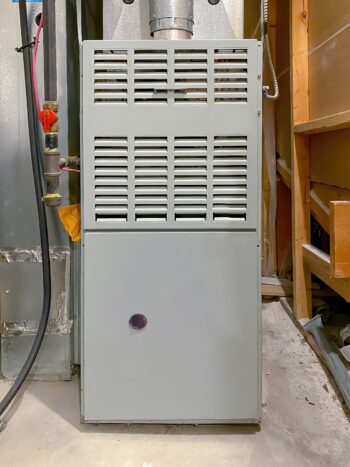
Have you noticed water dripping out of your furnace or pooling up around it? A furnace that leaks water is a common issue that only happens for a few different reasons. However, the specific problems that can cause this to happen differ depending on your furnace type. In this article, we’ll show you how to tell what type of furnace you have and also explain issues that can cause furnaces to leak.
Determining What Type of Furnace You Have
The first step to figuring out why your furnace is leaking water is to determine if you have a conventional unit or a high-efficiency condensing furnace. If you’re not sure, you can easily check by looking at the yellow EnergyGuide label to see what the furnace’s AFUE rating is. You have a condensing furnace if the AFUE rating is 90 or higher. If you can’t find the label, you can check to see what the exhaust flue is made of. The flue on a condensing furnace will usually be a plastic PVC pipe, whereas conventional furnaces have metal flues.
What Causes a Conventional Furnace to Leak?
The reason why it’s important to know what type of furnace you have is that a conventional furnace will only leak if the exhaust flue is loose, not properly fitted, or clogged. Any issue with the exhaust flue is a major safety hazard since it will prevent the combustion fumes from being properly vented outside and potentially allow carbon monoxide to leak into your home. This is why you should immediately shut a conventional furnace off if you see that it is leaking or water is pooling on the floor around it.
When a conventional furnace is venting properly, the combustion fumes are still quite hot when they get vented outside. If the furnace isn’t venting correctly, the fumes can cool down enough for condensation to form and water to start leaking out of the flue.
Possible Reasons Why Your Condensing Furnace Is Leaking
Condensing furnaces are much more energy efficient than conventional furnaces since they have two heat exchangers instead of just one. The secondary heat exchanger absorbs heat from the exhaust of the primary one that would otherwise be wasted. As a result, the fumes from a condensing furnace always get cool enough for condensation to form before they flow outside through the flue. This moisture production is why condensing units have a condensate drain system that captures the water so that it can flow outside or into a floor drain. This system consists of a drain pan that collects the water and a condensate line that transports the water away from the furnace.
Any time a condensing furnace is leaking you can be sure that there is an issue with the condensate drain system. In most cases, a leak indicates that one of the drain lines is clogged. Clogs can easily happen since heat and moisture can lead to mold and algae growing inside the drain lines and eventually causing them to become blocked. If the drain line is clogged, the water will start backing up and eventually overflowing out of the drain pan and leaking out of the furnace. It can also back up into the heating system, causing significant damage. Clearing a clogged drain line can sometimes be difficult and require specialized equipment, so this is a task that you’ll usually need to have a furnace technician perform.
Another issue is that your drain line can sometimes come loose or crack, leading to water leaks. In this case, a technician will need to replace it. There is also a chance that the leak indicates that the drain pan has rusted through or has a hole in it.
Depending on the location of your furnace and where the drain line runs, the unit may also have a condensate pump that forces the water out of the furnace and through the line. Most condensate pumps only last for around five years, so the leak could indicate that the pump is worn out and you need to replace it.
With over 35 years of experience, Totally Cool Heating & Air is one of Austin’s most trusted heating and air conditioning companies. We specialize in furnace and AC repairs and maintenance, and our team works on all models and types of heating and cooling units. You can also count on us for many other HVAC needs, such as ductwork sealing and upgrading your attic insulation. Contact us today to schedule an appointment with one of our experts.
